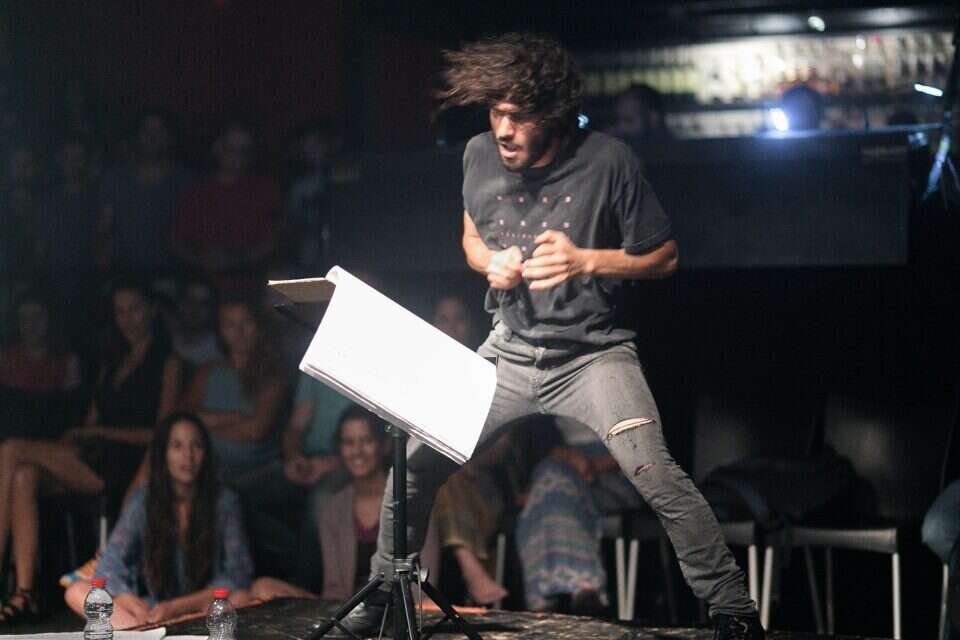In many cases, entering the show is a transition between two dimensions: from sacred to profane, from reality to imagination, from searching for a parking space in steamy heat to an experience of devotion and surrender.
In the show "Palace in Time", founded by Matan Daskel and his loyalist who opened the events of the "Tel Aviv Dance" festival, which demands great attention and a willingness to give oneself, the gap between the outside and the inside is even more present.
A crowd pours into the hall, and the multi-part orchestra is about to begin the show.
The festive red curtain is still closed while sounds are already heard from the stage.
In a surprising moment, one of many in the show, it opens.
Without pomp and without sincerity, but as if they were there all along, and now is the right moment to allow the audience to join.
The eye slowly gets used to the darkness and with patience more and more silhouettes are revealed: people, musical instruments, sheet music holders.
In this show, the obscurity is frequently present, and the modern eye, which is used to being wide open and absorbing endless stimuli - be it advertisements and screens or the blinding Middle Eastern sun - is handled here gently and with silk gloves.
An exercise in attention.
The "Palace Orchestra" show at Suzan Dellal, photo: Malu Zayon
Daskel, a dancer and musician, stands out by standing in the center of the stage.
He dominates the piece when his back is to the audience, and he will remain so for almost its entire length.
His face will not be revealed and he will remain a character who drives the work but maintains anonymity.
The show progresses, and then - almost without realizing it, the large orchestra gives way to the sounds of the synthesizer that repeats a bouncy and playful sound.
It plays again and again until it becomes catchy and can no longer let go.
The process of transplanting the melody has been completed, and it will now accompany the audience like a ghostly sound even after it ceases to be actually heard.
It is an exercise in attention, in listening to the movement of sounds, in paying attention to routine and marginal gestures.
The movement in this show takes place on many levels, even though it is not a rock in the conventional sense.
The musical movements of the orchestra remind of the dynamics of improvisation in motion, mainly in the group taking responsibility for what is created in real time.
Each participant must initiate, invent, join, give up and compromise with an understanding of the total experience, not the individual one.
It is the balance between the conflicting tasks and the internal seismograph of the participants that hold the piece together.
feeling restrained.
"The Palace Orchestra" show, photo: Diego Rosman
The arts of dance and music walk hand in hand throughout history: Tchaikovsky composed "Swan Lake" for the Bolshoi troupe in one of the most famous and beloved dance works of all time;
Stravinsky composed the masterpiece "The Rite of Spring" for the "Ballet Rus" company and was received with a tomato throw.
And it is impossible not to mention March Cunningham, the American choreographer who redefined modern dance, and together with the avant-garde musician John Cage, they changed the foundations of the medium in the way they connected sound to movement.
In the middle of the show "Palace in Time", in collaboration with the percussionist Trilok Gorto, Na'am plays with water and the guest singer Danielle Saint-Crief transforms breaths of air into heavenly singing - both are products of the same pioneering heritage that expanded the artistic range and made every object have a sound possibility.
Shoshana Demari once said that in concerts she "gives of herself" only 70% and leaves for herself a potential share, a remainder of everything she could have given in a concert but chose to be modest.
A sense of restraint was also present in the orchestra's performance, especially from the movement side, which could have developed much more given the high abilities of Daskel, an accomplished improviser and former dancer in the "Bat Sheva" troupe, and Yasmin Goder.
The one who danced, and a lot, is the musician and performer Ohad Fishoff, who allowed the movement to recharge him with his body and music.
The bodies of the other members of the orchestra gradually acclimated to the "Susan Dall" stage, which is used to host dancers.
In the grace moments of the show, the connection between the musicians and Daskel was so close that one could imagine him sending them flying off the stage with a wave of his hand.
The great power he used sparingly, as a sorcerer, created a unique experience of mesmerizing chaos, broken but whole.
were we wrong
We will fix it!
If you found an error in the article, we would appreciate it if you shared it with us

